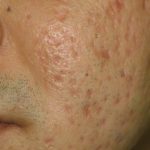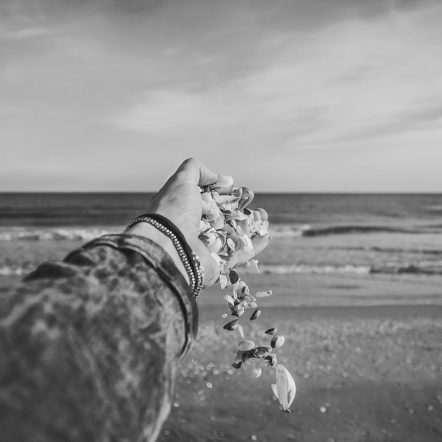Before discussing solutions to treat acne scars it’s important to know that there are different types of scars. Your treatment for acne scars will depend on the type of scars you have. It’s very common for people to have more than one type of acne scar so selecting the right treatment is crucial. You want to take your time and learn about the types of acne scars and the treatments available before making a decision.
Ice Pick Scars
Ice pick scars resemble deep or shallow pits or holes with jagged edges and steep sides. In some cases ice pick scarring is also called ‘depressed fibrotic scarring.’ Ice pick scars are most common on the cheeks.
Boxcar Scars
Boxcar scars are similar to chicken pox scars. Boxcar scars are oval shaped with sharp edges and vary in depth. These types of scars are usually found on the temple and cheeks.
Rolling scars
Rolling scars resemble rolling hills on your skin. It’s the result of damaged tissue beneath the skin. Because the rolling scars are a result of damaged tissue, resurfacing treatments will not work. You need to treat these types of scars with subcision. Rolling scars are common on the forehead and cheeks.
Hypertrophic scars
Hypertrophic scars are red small bumps that are found in the damaged area. These types of bumps are not only caused by acne but can be from other types of wounds. They also fade over time. A similar scar is keloid scar and these continue to grow making them a nuisance. These bumps can appear all over your body.
Acne Scar Treatments
You want to thoroughly do research so you are knowledgeable about the different types of scars and what types you have so you can find the treatment that will have the best results. Each treatment option has cons and pros and they will also improve some scar appearance while worsening others. Acne scar treatment can be expensive, so you need to make sure that you also chose a dermatologist who is not in it for the profit. Some truly care for  their patients while others care more about lining their pockets.
their patients while others care more about lining their pockets.
Here are tips to pick the right dermatologist for you:
- Before you select a dermatologist you should consult with a few of them. After receiving information with them, consult the internet with some research in order to determine which dermatologist is right for you. You want to be cautious around those who pressure you on the first visit to commit as well as push costly products and procedures onto you. It’s a good idea to search online the doctors and read reviews about them. If you don’t like what you read, keep looking.
- When you visit with a dermatologist, request them to specifically tell you what choice of action in regards to treatment they would recommend for your type of scaring. Also have them explain why they decided to prescribe you that particular treatment. It may be a good idea to bring a notepad with or a voice recorder. You may receive opposing treatment plans from each of the doctors you visit so it’s best to do some research on your own before seeing a dermatologist so you can bring up these other ideas and figure why they didn’t suggest the treatments you found for your type of scaring.
- Also during your initial visit, request to see pictures of their clients before and after the treatment. See if any of the people in the pictures have the same scarring as yours and notice how they look after the treatment. Also ask if you can contact any of the clients,
- Find out if they have experience with the treatments they have suggested for you. Also it’s necessary to know how long they have been a dermatologist.
For some people as they age notice a return of the scars even though they were successfully removed initially while others say the complete opposite. Every person is different. What works for some won’t always work for others so you want to be realistic with any expectations from acne scar treatment. It’s very important to do all the research you can so you can be prepared for anything. It’s always best to contact people who had successful experiences with acne treatment so you can learn about what they did to rid themselves of the acne scars. The best way to find people is through online communities and forums, support groups and dermatologists.
Treatments:
Subcision
Subcision costs around $1000 per treatment. Subcision is a treatment where the top layer of skin is detached from deeper layers. It allows for blood to flow into the opening and raise the skin. This treatment is used to treat rolling and shallow scars. Subcision usually requires multiple treatments.
Punch Treatments
This treatment costs from $50 – $150 per treatment. There are three different types of punch treatments. 1 – Punch Replacement: This requires cutting out the scar and replace it with skin grafts. 2 – Punch Excision: Requires the scar to be cut out and then the skin around it is stretched in order to avoid a skin graft. 3 – Punch Elevation: This procedure is similar to subcision as it involves cutting the scar loose and letting it heal. The result of this often ends up with the skin being slightly raised.
Chemical peels
A chemical peel costs between $600-$800 dollars per treatment. This procedure consists of having acid applied to the skin then removed. It removes the top layer of your skin. A chemical peel will make your skin smoother and this procedure will help if you have mild scarring.
Dermabrasion
Dermabrasion costs from $1200 – $2000 per treatment. With dermabrasion the top layer of skin is removed. The skin is numbed then a rotating abrasive disk sands off your skin. It’s a painful process and requires some down time. Those who have tried dermabrasion said they noticed the scars returned, so it only provides short-term results.
Laser Resurfacing
Laser resurfacing costs $2,500 dollars per treatment. This procedure is similar to dermabrasion. It requires the top layer of skin to be removed and it also gets your skin smooth. Lasers are used insead of the abrasive disks. People have reported the same results as those who had the dermabrasion. The acne scars can return.
Acne scar creams
Proactiv acne cream – there are many balms and creams that cures everything from scarring to impotence, but we can’t help question whether they work or not. Many people who have used these products say they don’t work while others say they do, so here is a list of those success stories.
- Creams that contain vitamin E and cocoa butter keep skin soft, healthy and elasticity. With regular use of these creams, scars will naturally vanish over time. Combining this with a healthy lifestyle and you’ll have great results.
- Applying 3x solution of hydrofluoric acid to the scarred skin two times a day for two weeks also helps diminish acne scars. This can damage skin, so use with caution and under supervision of a dermatologist.

